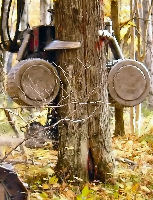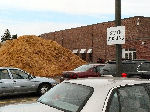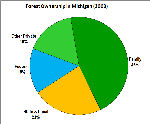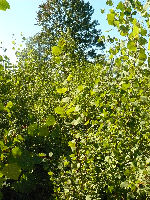

Home Page |
MICHIGAN FORESTS FOREVER TEACHERS GUIDE
 |
Socio-Economic Aspects |
|
This wood energy curriculum module is divided into five sections. Each section has a set of exploration topics to help guide students through an aspect of energy, energy use, and the role of woody biomass. Some materials are provided but, more important, resources are included for development of additional materials.
Socio-Economic Aspects
1 - Big Energy
2 - Wood Energy
3 - Environmental Aspects
4 - Socio-Economic Aspects
5 - Bringing It All Home
Like many ventures, a wood energy proposal must consider economic, environmental, and social factors. Sometimes, the social factors are considered less important because they don’t involve ‘hard science’ and tend to be ‘touchy-feely’. Yet, the most challenging barriers to wood energy projects tend to be social issues.
The values that people hold determine their opinions. Values are based on life experiences, which include just about anything. Values can be expressed through forest ownership, volunteer activities, vocational choices, social activism, leisure activities, and other outlets.
Concerns expressed about emerging energy projects may not be based on science, economics, or environmental issues. When people believe that a project will cause damage to the environment, a community, and their neighbors, they will often try to block such projects. Sometimes, evidence can persuade opposition. Other times, it cannot. Understanding the social dimensions of a community or local area will assist in siting and promoting a particular project.
What values do you hold that affect the way you might think about a wood energy project in your community?
What sort of proposal might you support and what sort would you not support? Why?
Select one of your values that affect your opinion about a wood energy plant. Where did that value come from?
This section explores answers to 11 questions. These eleven questions will likely generate other questions, which would be good to explore.
1. Why is cutting trees often considered bad?
2. What sort of noise might a local wood energy plant cause? Truck traffic increase?
3. How might people in your town react to a local wood energy plant proposal?
4. Who owns most of the forest in Michigan?
5. Do forest owners manage their forest?
6. What might be the economic impacts of wood-based energy? Taxes? Jobs?
7. How do ‘radical’ environmental groups affect public opinion about wood energy?
8. Are government subsidies OK for wood energy? Does the government subsidize other energy sectors?
9. Might woody biomass harvesting affect recreation? Hunting?
10. Why is ‘energy independence’ a common catch phrase?
11. What are the state government agencies that regulate wood energy?
1. Why is cutting trees often considered bad?
Sometimes, things that might make sense at first, really don’t make sense once the issue is explored. Tree cutting is often one of these topics. Of course, sometimes tree cutting can, indeed, have undesirable consequences and that complicates the discussion.
 Trees and forests have high visual quality. Changes, especially changes that
aren’t pretty, result in a negative response. While humans commonly regard
forest disturbance as ‘bad’, most trees and forest types depend upon disturbance
for regeneration and biodiversity. Nature uses wind, old age, insects,
diseases, and wildfire as disturbance agents. Forest management mimics these
natural ‘agents’ through a variety of practices (including clearcutting).
Nevertheless, reduced visual quality is commonly perceived as bad whether it’s
natural or human-caused.
Trees and forests have high visual quality. Changes, especially changes that
aren’t pretty, result in a negative response. While humans commonly regard
forest disturbance as ‘bad’, most trees and forest types depend upon disturbance
for regeneration and biodiversity. Nature uses wind, old age, insects,
diseases, and wildfire as disturbance agents. Forest management mimics these
natural ‘agents’ through a variety of practices (including clearcutting).
Nevertheless, reduced visual quality is commonly perceived as bad whether it’s
natural or human-caused.
Tree cutting is sometimes viewed as bad for wildlife, and wildlife are one of the top reasons why most people value forests. However, tree cutting (especially when done according to sustainable forestry principles) merely changes habitat characteristics. These changes are not favorable for some species of wildlife, but are beneficial for other species. The relationships between habitat characteristics and species habitat requirements are highly diverse and sometimes complex. Of course, forest habitats change with or without human intervention. Essentially, changes are good for some, neutral for some, and bad for others. Humans have the capacity to alter forest systems for desired outcomes . . . if ‘desirable’ can be agreed upon.
Harvesting results in large carbon releases, which is bad for the planet. This issue is more fully discussed elsewhere in section 3 of this curriculum, but this carbon comment is untrue when time, landscape factors, and wood products are considered. Healthy, vigorous forests sequester more carbon than older, declining forests. Management works to maintain forest health and vigor. Forestry, including timber harvest, can be useful in the mediation of global climate change.
Timber harvesting leads to soil erosion and reduced water quality. This can be true if timber harvesting is done incorrectly. However, nearly all logging contractors comply with ‘best management practices’ that protect water and soil resources. Trails and roads associated with logging have been more of an issue than the actual logging but these, too, are covered with ‘best management practices’.
Try to think of other reasons why forest tree cutting could be considered a bad practice. Then, think those reasons through using science-based critical thinking.
In Michigan, we are not running out of trees. We have more volume and acreage than at any time since the historic logging era.
References
Forest Management Guidelines for Michigan. 2010. Michigan Society of American Foresters.
Michigan's Forests; Our Growing Resource. 2012. MSU Extension. Flyer.
2. What sort of noise might a local wood energy plant cause? Truck traffic increase?
 Noise pollution has become an increasingly prominent issue in some communities.
A wood-using facility has machinery that can make noise and trucks that deliver
wood can also be noisy. Each facility will have a noise profile specific to
each situation. A large pulp mill or sawmill can, indeed, be quite noisy. A
small to medium sized district energy facility has little associated noise,
usually at or below currently ambient noise levels. Truck deliveries to most
mills occur during the day when most people are active or away from home. A
medium-sized district energy facility will be supplied by 5-10 trucks per week
with less noise than lawn mowers or snow blowers.
Noise pollution has become an increasingly prominent issue in some communities.
A wood-using facility has machinery that can make noise and trucks that deliver
wood can also be noisy. Each facility will have a noise profile specific to
each situation. A large pulp mill or sawmill can, indeed, be quite noisy. A
small to medium sized district energy facility has little associated noise,
usually at or below currently ambient noise levels. Truck deliveries to most
mills occur during the day when most people are active or away from home. A
medium-sized district energy facility will be supplied by 5-10 trucks per week
with less noise than lawn mowers or snow blowers.
Many of the district energy systems in the upper Lake States are at schools, where quiet is a premium and traffic is certainly an issue. Pinecrest Health Care Facility, in Powers, Michigan, also has particular interest in issues of noise, odor, emissions, and truck traffic. These facilities have discovered woody biomass heating (and cooling, in some cases) is not only cost effective, but also compatible with their primary operations.
3. How might people in your town react to a local wood energy plant proposal?
What do you think people in your community would say about a proposal to build a wood energy plant? What kind? What about a district energy plant? A larger combined heat and power plant? The conversion of a coal-burning boiler to a woody biomass boiler?
What issues might people in your community raise? Wood supply? Odor? Jobs? Economic development? Noise? Environmental issues? Finances? Energy independence? What do people in your age group think about wood-based energy?
Consider some of these case studies.
4. Who owns most of the forest in Michigan?
 Michigan Forest Ownership |
The largest single forest owner is the State of Michigan (4.5 million acres), with most of that within the state forest system. The federal government is the second largest forest owner (3 million acres), mostly in the national forest system. However, private, non-industrial owners (family owners) control the largest category, nearly nine million acres. The remainder is owned by corporations, hunt clubs, non-government organizations, and other groups (3.2 million acres).
Ownership matters. Each owner determines what, if any, timber will be harvested on a property. Public lands have large areas set aside where harvest is not allowed, or is only minimally allowed. Different pieces of the public land will have different management objectives. And, there are important differences between state and federal land. Family forest parcels are becoming increasingly small as property is passed from one generation to the next. Many of the new owners also are less inclined to harvest timber than older generations. Reduced timber harvest has significant impacts to the economy and forest health. Corporations, mostly investment organizations, manage over two million acres, primarily for net income from timber harvesting. However, most of this property is enrolled in a third part certification program (or two programs). Also, most of this forest is open to the public for hunting and fishing, and often other outdoor recreation as well.
5. Do forest owners manage their forest?
Ownership has a lot to do with how forests are managed. Public lands go through an extensive process dictated by laws and regulations, and sometimes due to litigation. Private forests, on the other hand, are managed according to the various preferences of the owner. All categories of private land account for over 60 percent of Michigan’s forest resource, over 12 million acres. So, there are many values and intentions that go into the management (or non-management) of private forests.
While Michigan has a total of about 20 million acres of forest, a large portion of that forest is not managed, at least not in terms of timber harvest, habitat development, and forest health. For a variety of reasons (and laws), significant areas of both federal and state lands are not managed. This amount changes over time, but has gradually increased over the decades.
On the other hand, private forest owners (in Michigan) can do nearly anything with their forests. Corporations focus on timber management and forest regeneration. Hunt clubs manage (if they manage) for high deer densities and other game species. Moms and Pops do a wide range of things, from timber, to deer, to nothing. Also, large portions of the nearly nine million acres of “Mom and Pop” ownership changes ownership every few years. Unless the forest is enrolled in special Michigan forest property tax laws, the ‘management’ of these private parcels changes regularly, and forest conditions sometimes change dramatically with an ownership change.
Wood energy creates a new market for forest material that was previously unmarketable. As new markets are built, area forest owners have the option to manage their forest differently, often better with more choices. However, a new market, even for materials that might not have been otherwise marketable, will not be decision-changer for most ownerships. New wood energy markets carefully evaluate forest owner willingness to sell timber. Just because it's growing, doesn't mean it can be brought to market.
References
Forest Ownership in Michigan, 2006. Brett Butler. USDA Forest Service. 1 page summary. Tables, 19 pages.
Forest Owners of the United States, 2006. NRS-27. USDA Forest Service. 78 pages.
Michigan Forest Biofuels Research, Sustainable Production of Material.
6. What might be the economic impacts of wood-based energy? Taxes? Jobs?
Michigan exports about $30 billion every year for energy, roughly 10 percent of all the goods and services produced in Michigan. This is good for states and countries that sell coal, oil, and natural gas. Wood based energy has the potential to keep some of those dollars local and working within the community. Dollars kept local circulate through and support local economies. They add to stability, generate jobs, add to the tax base, and improve the quality of life.
Wood energy projects have the potential to build infrastructure that is not easily ‘out sourced’ or imported. Of course, there are many economic and fiscal factors to be considered, and each situation is different, but wood energy has worked in many countries and in different regions of the United States. There are likely many applications in Michigan where wood-based energy systems would make a lot of sense.
References
Sustainable Forest Biomass: Promoting Renewable Energy and Forest Stewardship. 2009. Environmental and Energy Study Institute.
A National Wood-to-Energy Roadmap. 2011. 25x25 Alliance. 40 pp.
7. How do ‘radical’ environmental groups affect public opinion about wood energy?
Groups that advocate a ‘no touch’ or ‘anti-management’ approach to forests and natural resources come from a philosophical base that usually fails to consider environmental, social, and economic factors in human society. Sometimes, arguments appear well-intentioned but are usually neither accurate nor possible. Catchy ideas, popular wildlife species, or specific situations are picked-up by news media and serve as emotional flash points to generate financial and moral support. Sometimes elements based in science are creatively used (or misused) to build campaigns that are less than accurate but can generate donations or sway public opinion in one direction or another.
It’s important to apply critical-thinking skills to determine the merits of claims made through the public media. Public media are designed to sell newspapers, TV ads, and radio spots. Using flashy news bytes helps sell products, not always accuracy. Information is not necessarily based in appropriate science or critical thinking. A reasonable dose of skepticism about claims that seem a bit too ‘edgy’ is probably good strategy.
8. Are government subsidies OK for wood energy? Does the government subsidize other energy sectors?
Subsidies and other economic policy tools are used by governments to encourage policies that they establish. Many of these tools affect agriculture and energy sectors of our economy. Some people believe these to be good practices and others object to them. Some folks will advocate that free enterprise will serve society the best. Others argue that some level of intervention is necessary to provide equity among citizens. These debates have been ongoing since before our nation was founded. The underlying philosophies date back to classical Greek times.
Subsidies for any product or industry are objectionable by those who ascribe to a pure free market perspective. Government should not be part of a market economy and subsidies manipulate trade by favoring one entity over another.
The other side of the argument has to do with using subsidies (and other tools) to protect the public good or move society in a direction that a government believes necessary for public good.
The renewable energy industry (wood, wind, solar, et al.) is a high risk venture that must compete against large, established, and already heavily subsidized fossil fuel industries. One group would say renewable energy should ‘sink or swim’ based on its own merits. Others claim that without government assistance, renewables would not be able to get a toehold in the energy sector.
It can be difficult to know which policy is best, or when a group of economic tools should or shouldn’t be applied. Understanding the economic implications of one choice or another can be difficult. However, as the ‘rules’ change, sometimes abruptly, the repercussions for an emerging industry can be huge. Oftentimes, investment dollars refuse to flow into an industry where the government policy is volatile. Would you invest a $1000 in a company when conditions for them to pay the money back were out of your control and their control?
References
The Tragedy of the Commons. 1968. Garrett Hardin
9. Might woody biomass harvesting affect recreation? Hunting?
These past-times are important to both the citizens of Michigan and the Michigan economy. Forests are critical assets (and well-managed forests increase benefits). So, the idea of harvesting additional fiber from the forest concerns many.
 Young aspen is important for many species of wildlife. |
To address these concerns, considerable research and analysis has been accumulated by forest scientists, wildlife ecologists, and other scientists. Forest ecology, nutrient cycles, environmental conditions, and many other subjects have been researched for decades. Using this information, and generating new information, will clarify how biomass harvesting can affect recreation, hunting, and other forest activities.
The impacts of increased woody biomass removal on recreation and hunting are likely to be minimal. However, the public acceptance and socio-cultural perceptions will be more challenging. The appearance of post-harvest forest will vary among various user groups. The habitat implications for game species will vary with the forest type, soil type, geographical location, and other factors.
Game species benefit from timber harvest activities, particularly clearcutting. These species are adapted to the forest conditions created by wildfire, windstorm, and other stand-replacing natural events. Management mimics these natural events but they become scheduled and more controlled in both time and spatially. This benefits human beings. Woody biomass harvesting can help regenerate critical habitat, especially in vegetation that could not otherwise generate income. On forested lands where more traditional harvest practices are common, the sale of woody biomass can enhance the income from a timber sale when working towards habitat objectives.
10. Why is ‘energy independence’ a common catch phrase?
Fears (some justified, some not) about the role of potentially (or actual) hostile governments supplying the USA with energy (primarily oil) have promoted an interest in supplying more of our energy consumption from domestic sources, or at least from our friends. For example, when political upheaval in the Middle East happens, the price of oil jumps considerably. Just about everything we use, especially food, depends upon energy derived from oil (gasoline and diesel). So, the price of nearly everything, especially food, jumps accordingly. This places more of a burden on the poor than on the middle class or wealthy folks. It also causes considerable ‘grumpiness’ among most people who don’t like to pay more for goods and services. Sometimes, environmental damage occurs from fossil fuel extraction, and this can also drive-up the price of fossil fuels. Such damage can also result in government environmental protection policy changes that cause energy prices hikes.
Politicians and energy strategists understand that unhappy constituents make for increasing civil unrest. Reducing price volatility makes for more stable lifestyles. Because quality lifestyles are so important to so many, an amount of ‘spin’ can sometimes be placed on the marketing of certain programs, policies, and products. The term energy independence sounds patriotic and, along with some underlying fear, can sway public opinion in directions some politicians and marketers wish to see. These actions, of course, may or may not reflect actual conditions.
However, price stability for energy certainly adds to more stable human populations and governments. What sorts of things do you hear when the price of gasoline jumps 50 cents or more over a short period of time? What does $5.00/gallon mean to you? That's been the price (or higher) in many parts of the world. Is that a good time for the government to enact energy independence policies? Will proposed policies really help to make the USA more energy independent or are there other motives involved? Might a controversial program, such as carbon cap-n-trade, be more acceptable when citizens are stressed by high energy costs?
The "independence" situation varies among different fossil fuels. What we hear most about is the price of a barrel of oil and the subsequent price of a gallon of gasoline. The import/domestic balance of petroleum is different than that for coal or natural gas. And, most oil imports come from countries that the USA currently considers friendly. Nevertheless, oil from the Middle Eastern countries does come with politics filled with conflict. Issues of "independence" change with the fossil fuel considered. The words "energy" and "oil" are not synonyms. Section 1 "Big Energy" of this curriculum addresses some of these issues.
References
11. What are the state government agencies that regulate wood energy?
Regulations tend to kick-in when boiler sizes reach a certain size. There are about 275 regulated wood-fired boilers in Michigan. The hundreds of wood-fired stoves and furnaces used in homes and small businesses are currently unregulated, for the most part. Those numbers are not tracked. However, some local governments have enacted air quality measures that exclude many such furnaces and stoves.
In Michigan, the Department of Labor and Economic Growth (DELEG) is charged with administering boilers and commercial furnaces. The Michigan Public Service Commission (within DELEG) deals with utilities that provide electricity and heat. Michigan energy policy is based on actions within the legislature, federal policy, industry needs, and other factors.
References
Exploring Woody Biomass Retrofit Opportunities In Michigan Boiler Operations. 2007. Southeast Michigan Resource Conservation & Development.
Michigan Public Service Commission and Michigan Renewable Energy Program
Michigan Renewable Energy Program
 |
This website was developed and created by Michigan State University Extension for the teachers of the State of Michigan. |
Page Name:
4-SocioEcon.htm